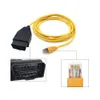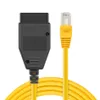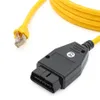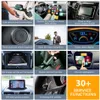If you’re in the market for a diagnostic tool for your BMW, look no further than an ENET cable. This powerful tool allows for precise programming, faster data transfer, and customization options that other tools just can’t match. Many BMW models are compatible with the ENET cable, although some may require additional software or updates. Setting up the cable is a breeze with our step-by-step instructions, and we even provide troubleshooting tips for any common issues you may encounter. Say goodbye to slow data transfer and limited customization options – make the switch to an ENET cable today and take control of your BMW like never before.








Benefits of using an ENET Cable
One of the main advantages of using an ENET cable is that it provides precise programming. With this cable, you can easily program your vehicle’s engine control unit (ECU) with custom settings, ensuring that your car operates exactly as you want it to. This is especially useful for those who want to extract the maximum performance from their vehicle or make modifications to it.
Another benefit of using an ENET cable is that it enables faster data transfer. Traditional diagnostic tools often rely on outdated communication protocols, which can result in slow data transfer rates. However, an ENET cable uses Ethernet technology, allowing for much faster data transfer rates. This means you can quickly diagnose issues with your vehicle and make necessary adjustments without wasting any time.
Customization options are also a major advantage of using an ENET cable. You can easily modify your vehicle’s settings to suit your driving preferences, whether you prefer a more aggressive or fuel-efficient driving style. This level of personalization is not possible with other diagnostic tools, making an ENET cable an essential tool for enthusiasts who value customizability.
In addition to these benefits, an ENET cable is also easy to use. It requires no special training or technical knowledge, making it accessible to anyone who wants to perform advanced diagnostics on their vehicle. Many cables also come with intuitive software that guides users through the process, further simplifying the process.
Compatibility
Firstly, it is essential to understand what an ENET cable is and its purpose. An ENET cable is essentially an Ethernet cable that connects a BMW car to a computer or laptop. This connection allows for the transfer of data between the car and the computer. The cable is used primarily for diagnostics and coding purposes. With the use of an ENET cable and software, individuals can access advanced diagnostic features that would usually only be available to authorized BMW dealerships.
Now, when it comes to compatibility, there are different variations of BMW models that are compatible with an ENET cable. For instance, almost all BMW models produced after 2010 are compatible with an ENET cable. However, models produced before 2010 may not be compatible or may require additional software or updates to work properly. It is important to note that even within the same model year, there can be variations in compatibility depending on the specific features of the car.
If you are unsure whether your BMW model is compatible with an ENET cable or not, it is best to do thorough research before making a purchase. This is because buying an incompatible ENET cable can lead to unnecessary expenses and frustration. Additionally, it is essential to ensure that the software being used with the ENET cable is up to date. This will prevent any software errors that could affect the car’s performance.
Installation and Setup
Step 1: Purchase the Right ENET Cable
Before you start installing and setting up the ENET cable, you need to ensure that you have purchased the right one for your BMW vehicle. The ENET cable comes in different configurations, depending on the model of your car. Make sure that you choose the appropriate one, as using the wrong cable may cause problems during installation and setup.
Step 2: Download the Required Software
Once you have the right ENET cable, the next step is to download the software required to run it. You can find various software options online, but we recommend using the BMW E-Sys software, which is specifically designed for BMW vehicles. Once downloaded, extract the files to a folder on your computer.
Step 3: Install the Drivers
Before you can connect your ENET cable to your BMW vehicle, you need to install the drivers on your computer. The driver installation process varies depending on your operating system, so make sure to follow the instructions carefully. Once the drivers are installed, you can proceed to connect your ENET cable to your car.
Step 4: Connect the ENET Cable to Your Vehicle
To connect the ENET cable to your car, locate the OBD-II port, which is usually located beneath the dashboard on the driver’s side. Insert the ENET cable into the port until it clicks into place. Next, connect the other end of the cable to your computer via the USB port.
Step 5: Configure the Settings
Once the ENET cable is connected to both your car and your computer, you need to configure the settings to establish a connection between them. Open the BMW E-Sys software and select your car’s model and year. Then, click on the Connection icon and select the ENET cable option. The software should now detect your car and establish a connection automatically.
Troubleshooting Tips and Common Issues
During the installation and setup process, you may encounter some common issues such as connection errors, driver conflicts, or compatibility issues. To troubleshoot these problems, try the following steps:
– Ensure that you have installed the correct drivers for your operating system.
– Make sure that you have selected the right ENET cable configuration for your car’s model and year.
– Check that your car’s battery has enough charge to power the connection.
– Restart your computer and try again.
Conclusion
In conclusion, the ENET cable is an essential tool for BMW car owners who want to take control of their car’s performance and features. Installing and setting up the ENET cable is relatively easy if you follow the steps provided above. Remember to purchase the right cable, download the required software, install the drivers, connect the cable to your car, and configure the settings. By doing so, you can enjoy all the benefits that the ENET cable has to offer, including programming your car’s features, diagnosing problems, and upgrading its performance.
FAQ
Q1. What is an ENET cable and how does it work with BMW diagnostics?
The ENET cable is a specialized tool that connects your BMW vehicle’s OBD-II port to your computer, allowing you to access detailed diagnostic information about the car’s performance, faults and more. The cable enables fast and accurate data transmission from the car to your computer or other diagnostic device, providing precise programming options for customization and optimization of your BMW vehicle’s configuration.
Q2. Is the ENET cable compatible with all BMW models?
The ENET cable is designed and tested to work with most BMW models produced since 2008, including Series 1-7, X1-X6, and Z4 models. However, it is important to make sure that your BMW vehicle is equipped with the necessary hardware and software features to support the use of the ENET cable for diagnostics and programming purposes.
Q3. Can I use the ENET cable to diagnose specific issues with my BMW vehicle?
Yes, the ENET cable provides detailed diagnostic information and error codes that can help identify specific issues affecting your BMW vehicle’s performance and function. By connecting the cable to your computer or diagnostic device, you can access real-time data on engine speed, fuel consumption, DTCs (Diagnostic Trouble Codes), and more, helping you to pinpoint the root cause of any problems and take appropriate corrective action.
Q4. How do I use the ENET cable to program my BMW vehicle’s settings?
Using the ENET cable to program your BMW vehicle is a simple process, but it requires some technical knowledge and expertise. You will need to install the necessary software drivers on your computer, connect the cable to your OBD-II port, and then run the diagnostic software to access the programming options. Be sure to follow the instructions carefully, and always take precautions to avoid damaging your vehicle’s electronic systems during the programming process.